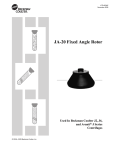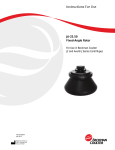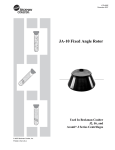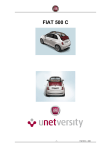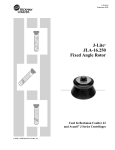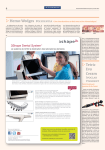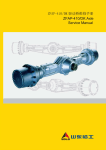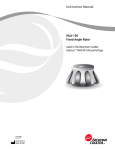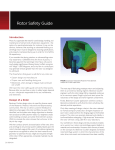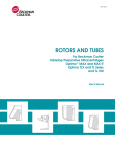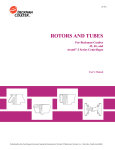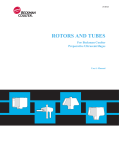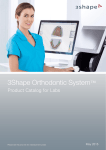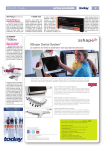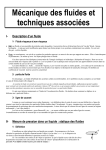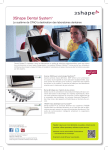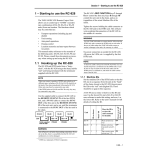Download INSTRUCTION MANUAL Model F10BCI–6x500y
Transcript
FIBERLite CENTRIFUGE, Inc. Piramoon Technologies INSTRUCTION MANUAL Model F10BCI–6x500y High Speed Rotor For use only in Beckman Coulter Avanti J or HP centrifuges except the Avanti J-HC. Not for use in any other Beckman Coulter centrifuge, or any other centrifuge. Type: Volumetric Capacity: Maximum Speed: Maximum RCF: Weight: Material of Construction: Rotor Codes: Fixed Angle 6 x 500 mL 10,000 rpm 17,696 x g 13.2 kg / 29 lb. Carbon Fiber Composite F500* in Avanti J and HP series centrifuges 500† in Avanti J-E centrifuges *Rotor Code F500 was previously F10. † Rotor Code 500 was previously 10.1. 422 Aldo Avenue, Santa Clara, CA 95054 USA 800.PTI.FUGE www.piramoon.com Rev. 3/7/8 FIBERLite® CENTRIFUGE Rotor Products User Reference Manual 04/05B Rev. 3/7/8 Rev. 3/7/8 FIBERLite® CENTRIFUGE ROTOR USER MANUAL Contents Page A. GENERAL INFORMATION 1. Safety Marks and Notices 2 2. Rotor Model Designations 5 3. Characteristics of Composite Materials 6 4. Rotor Preparation 6 5. Tube and Bottle Preparation 6 6. Rotor Care, Cleaning and Disinfecting 9 7. In Case of Trouble - What To Do 10 8. Product Return Procedure 10 9. Field Rotor Inspection Program (FRIP) 11 10. Warranty Statement 12 • Glossary (including essential centrifugation formulas) 14 • Patents and Trademarks Notice 15 B. RELATIVE CENTRIFUGAL FORCE (RCF) Table © 2005 16 ® FIBERLite CENTRIFUGE / Piramoon Technologies, Inc. (PTI®) 04/05B Rev. 3/7/8 1 1. Safety Marks and Notices CAUTION- SAFETY MARK! This mark points to an important safety instruction in connection with the operation and handling of the rotor. Failure to do so may void warranty or result in damage to the rotor, centrifuge, and in the loss of samples. The operator is instructed to follow the accompanying instructions before use or maintenance of FIBERLite® CENTRIFUGE rotors and accessories. WARNING - SAFETY MARK! This mark signifies a critical safety consideration that must be adhered to. Failure to do so creates the potential of harm to the rotor, centrifuge and even personal injury. The operator is strongly urged to strictly follow all instructions that accompany this symbol. IMPORTANT SAFETY CONSIDERATIONS! - Please read before using your rotor - Chemical and Biological Safety Use solutions, samples or material that are chemically or biologically active or potentially dangerous mixtures, only after you read, understand: • all safety documents, data sheets or other information provided by the solutions, samples, materials, or bio-active material, parts, components, instruments and tools involved in the experiment, • all relevant federal and local safety regulations, and • institute all necessary precautionary and safety steps. If a supplier provides any of the biologic products involved in the experiment, you must familiarize yourself with all cautionary information available from the supplier’s literature with respect to the origin and properties of these products. If such information is inadequate or unavailable, contact your institution’s safety officer. © 2005 2 ® FIBERLite CENTRIFUGE / Piramoon Technologies, Inc. (PTI®) 04/05B Rev. 3/7/8 FIBERLite® CENTRIFUGE ROTOR USER MANUAL In addition, you must keep the following under consideration at all times before, during and after centrifugation. • Spills may generate aerosols. Be familiar with and adhere to safety precautions for aerosol containment. Implement aerosol containment particularly when working with virulent organisms such as Hepatitis (B and C), HIV (all forms), mycobacteria, etc. Infectious sample mixtures must be handled according to appropriate laboratory procedures and methods to prevent potentially lethal consequences. • Handle all body fluids, whether human or animal, as if they are capable of transmitting lifethreatening infectious disease. Available laboratory tests do not eliminate the hazard. • Follow local and federal guidelines related to health, safety and environment to dispose waste solutions. • If, at the end of a centrifuge run, there is evidence of leakage of biologically active or radioactive samples, you should assume that some fluid escaped the rotor. In that case, you should immediately start appropriate decontamination procedures for the rotor (see section 2.3.3), centrifuge and all related accessories, such as vacuum pump(s) and connecting vacuum tubes that might have been exposed to the sample. If not certain, call the manufacturer of your centrifuge for instructions. Mechanical Limitations and Worker Safety The failure mode of FIBERLite® CENTRIFUGE rotors is much different than rotors made from metals. In case of a total failure and disruption, FIBERLite® CENTRIFUGE rotors will cause less damage to the centrifuge than their metallic equivalents. However, total disruption of a large or high-energy rotor may still result in some damage to the centrifuge and loss of samples. Make sure you follow instructions in this manual and in other documents provided by manufacturers of the centrifuge, bottles, and tubes and by suppliers of sample mixtures or reagents. Follow all operational procedures correctly for each run. Never use a rotor without a lid. Super-speed or General Purpose rotors not tied down securely on the spindle may jump off and cause damage to the drive shaft and the centrifuge chamber. Never attempt to touch or stop a rotor by hand. Failure to do so may damage the surface finish of the rotor and, over time, expose some pointed ends of carbon filaments, which may break through the skin like a wooden splinter. © 2005 ® FIBERLite CENTRIFUGE / Piramoon Technologies, Inc. (PTI®) 04/05B Rev. 3/7/8 3 Trying to stop a rotor also presents a serious personal hazard: loose items like scarves or sleeves of a lab-coat can be caught by the spinning rotor and cause injury. Excessive vibration of a high-speed centrifuge will indicate a grossly unbalanced rotor. Stop the run immediately, remove all bottles from the rotor and check counterbalancing of the bottles in accordance with the manufacturer of your centrifuge. Most high/super centrifuges require counterbalancing within ±1.0 gram. Do not exceed maximum rotor speed under any circumstance. Speed reduction may be necessary because of weight considerations of tubes, adapters, condition of the rotor, or the density of the solution being centrifuged. Be sure to follow appropriate instructions contained in this rotor manual. Do not put a rotor covered with moisture on the pre-cooled drive spindle, or it can freeze into place. Never leave the rotor on the hub for long periods. Keep mating surfaces of the rotor and spindle clean. If any unusual vibrations, sounds or odors occur, turn off power to the centrifuge immediately and do not operate the centrifuge until the cause of the improper behavior is determined. Do not try to lift a rotor by force or by swaying it. If not removed immediately, rotors may stick to the spindles of some high-speed centrifuges due to condensation that can quickly freeze over the spindle. Leave the rotor in the centrifuge and wait until the centrifuge comes down to room temperature. Then, try lifting the rotor again. If you still cannot remove the rotor, contact Beckman Coulter Field Service for advice. Lifting, carrying and reaching in-and-out of the centrifuge poses the potential of lower back-injuries. Lift, carry and handle the rotor with care, with your body in complete balance at all times. Ask your institution’s safety officer or write to Occupational Safety and Health Administration (OSHA) for advice. Dropping the rotor on the floor from a bench-top © 2005 4 ® FIBERLite CENTRIFUGE / Piramoon Technologies, Inc. (PTI®) 04/05B Rev. 3/7/8 FIBERLite® CENTRIFUGE ROTOR USER MANUAL distance may render it unusable. If a rotor is dropped on the floor, you must contact Beckman Coulter Field Service to arrange for a free inspection. Never use any abrasive tools to clean the rotor. If needed, uses soft brushes and wash only with mild soap or detergent solutions. High or super speed rotors need to be screwed onto the spindle using the tie-down knob on the rotor lid. IMPORTANT: It is the customer’s responsibility to decontaminate, disinfect or sterilize the rotor and ensure complete safety before contacting Beckman Coulter, Inc. for service or inspection. 2. Rotor Model Designations FIBERLite CENTRIFUGE high and super speed rotors are named to provide information about them following some conventional designations. For example, the model name F10BCI6x500y indicates that the rotor is a Fixed angle high speed rotor, capable of achieving a maximum speed of 10,000 rpm, equipped with a Beckman Coulter, Inc. hub, and that the rotor has 6 cell cavities with 500 mL capacity each. The y designates Enhanced Liquid Containment. © 2005 ® FIBERLite CENTRIFUGE / Piramoon Technologies, Inc. (PTI®) 04/05B Rev. 3/7/8 5 3. Characteristics of Composite Materials A composite structure is a non-chemically combined material created by the synthetic assembly of two or more components. These components include selected filler or reinforcing agent and a compatible matrix binder, i.e., a resin, in order to yield specific characteristics and properties. The components of a composite material do not dissolve or otherwise merge completely into each other, but they act in concert. The components and interface between them can be physically identified and characterized. In addition, it is the behavior and properties of the interface that generally control the properties of a composite structure. The key advantage the composite technology is that it provides wide design flexibility and manufacturing latitude to meet the technical, performance and cost demands imposed by different applications. The goal in creating a composite structure is to combine similar or dissimilar materials in order to develop specific properties that meet desired requirements. From the centrifugation point of view, what make composite materials, specifically carbon fiber and epoxy combinations, highly desirable are that they do not corrode and that they provide significantly better strength to density and stiffness to density ratios than both aluminum and titanium. These properties, when applied properly, result in better, safer, higher performance centrifugation products. 4. Rotor Preparation It is advisable to keep your FIBERLite® CENTRIFUGE carbon fiber rotor in a cold-room, so that the run can start immediately after bottles are placed in the rotor, eliminating the need to wait for temperature equilibration in the centrifuge. If kept at room temperature, FIBERLite® CENTRIFUGE rotors will take approximately 1-3 hours to cool down to under 10oC after it is placed in a refrigerator. However, because carbon fiber rotors provide effective temperature insulation, you only need to chill your sample. Once placed in the rotor, the rotor will maintain up to 95% of the sample temperature throughout the spin cycle. It is always important to visually inspect the rotor and its components before and after each run for any unusual nicks, checking, or other abnormalities. See Rotor Care, Cleaning and Disinfecting. 5. Tube and Bottle Preparation Commonly used rotor bottles have a flat bottom with rounded edges and may be covered with either a screw closure or a sealing cap. Other types of bottles with conical or rounded bottoms may be used with inserts. Typically these bottles are supplied with a non-contaminating screw closure without a liner. The following Beckman Coulter tubes, bottles, and accessories can be used in this rotor. © 2005 6 ® FIBERLite CENTRIFUGE / Piramoon Technologies, Inc. (PTI®) 04/05B Rev. 3/7/8 FIBERLite® CENTRIFUGE ROTOR USER MANUAL Tube Required Accessory Max. Fill Volume (mL) Description Description Dimensions and Volume 355605 (pkg/6) polycarbonate bottle w/cap assembly 69 x 160 mm 500 mL 465 none 10,000 361691 (pkg/6) polypropylene bottle w/cap assembly 69 x 160 mm 500 mL 445 none 8,000 356011 (pkg/6) polypropylene wide mouth bottle w/screw cap 62 x 120 mm 250 mL 250 adapter, PETb 362750 (pkg/2) 10,000 356013 (pkg/6) polycarbonate wide mouth bottle w/screw cap 62 x 120 mm 250 mL 250 adapter, PET 362750 (pkg/2) 10,000 363647 (pkg/25) polycarbonate opentop tube 29 x 104 mm 50 mL 40 adapter, polypropylene 356996 (pkg/1) 10,000 363664 (pkg/25) polycarbonate tube w/snap-on cap 29 x 104 mm 50 mL 40 adapter, polypropylene 356996 (pkg/1) 10,000 357000 (pkg/6) polycarbonate bottle assy w/liquid-tight cap assy 29 x 104 mm 50 mL 42 adapter, polypropylene 356996 (pkg/1) 10,000 357001 (pkg/6) polyallomer bottle assy w/liquid-tight cap assy 29 x 104 mm 50 mL 34 adapter, polypropylene 356996 (pkg/1) 10,000 357002 (pkg/25) polycarbonate bottle w/screw cap 29 x 104 mm 50 mL 34 adapter, polypropylene 356996 (pkg/1) 10,000 357003 (pkg/25) 357005 (pkg/25) polyallomer bottle w/screw cap polypropylene thickwall tube w/snap-on cap 29 x 104 mm 50 mL 29 x 104 mm 50 mL adapter, polypropylene adapter, polypropylene 356996 (pkg/1) 356996 (pkg/1) natural 29-mm cap red 29-mm cap green 29-mm cap yellow 29-mm cap blue 29-mm cap 356264 357359c 357360c 357361c 357362c 42 31 Part Number Max. Speeda (rpm) Part Number 10,000 10,000 c 357007 (pkg/25) polypropylene thickwall open-top tube 29 x 104 mm 50 mL 50 adapter, polypropylene 356996 (pkg/1) 10,000 363664 (pkg/25) polycarbonate tube w/snap-on cap 29 x 104 mm 50 mL 40 adapter, polypropylene 356996 (pkg/1) 10,000 d conical tube 29 x 115 mm 50 mL adapter, polypropylene 356965 (pkg/1) 10,000 d conical tube 17 x 120 mm 15 mL adapter, polypropylene 356960 (pkg/1) 10,000 © 2005 d d ® FIBERLite CENTRIFUGE / Piramoon Technologies, Inc. (PTI®) 04/05B Rev. 3/7/8 7 Tube Part Number Description Dimensions and Volume d round-bottom tube 17 x 120 mm 15 mL d round-bottom tube 13 x 100 mm 7 mL d round-bottom tube 12 x 75 mm 4 mL Max. Fill Volume (mL) Required Accessory Max. Speeda (rpm) Description Part Number adapter, polypropylene 356994 (pkg/1) 10,000 d adapter, Delrine 356973 (pkg/1) 10,000 d adapter, Delrine 356967 (pkg/1) 10,000 d a Maximum speeds listed are guidelines only. Polyethylene teraphthalate. c Polypropylene; package of 25. d Commercially available. Observe manufacturer’s speed and fill volume guidelines. e Delrin is a registered trademark of E.I. Du Pont de Nemours & Company. b To ensure leak-proof performance, especially at forces greater than 10,000xg or when spinning hazardous materials, sealing cap assemblies (cap and gasket) should be used. Other special purpose caps, made for low temperature storage or to resist aggressive chemicals are specified as such by their respective manufacturers. For certain applications, round-bottom or conical-bottom tubes may also be used with appropriate adapters for support during centrifugation. These types of bottles are typically specified with reduced g-force rating. Check with the manufacturer for the maximum g-force rating of your bottle. There are several different polymeric materials used in the construction of centrifuge bottles. Each material offer different kinds of resistance to solvents, pH, temperatures, environments, autoclaving and stress crack. Eventually, however, all of these materials will develop stresscracks from continued use. Consult with the bottle manufacturer to select the correct type that will suit your application, and deliver desired performance and cost. Glass tubes or bottles are rarely used in a high-speed rotor. However, if glass tubes are to be used, follow manufacturer’s instructions to sure that the material can withstand the required g-forces. © 2005 8 ® FIBERLite CENTRIFUGE / Piramoon Technologies, Inc. (PTI®) 04/05B Rev. 3/7/8 FIBERLite® CENTRIFUGE ROTOR USER MANUAL 6. Rotor Care, Cleaning and Disinfecting The rotor body does not need washing and cleaning after every run. However, periodic washing under warm water, using a mild detergent solution will help reduce the amount of salt deposits from spills and permit easy placement of sample bottles in the rotor cavities. FIBERLite® CENTRIFUGE’s specially formulated LabCARE™, also known as FIBERClene™ is designed to extend the life of your carbon fiber rotor, as well as to provide an effective, ecologically safe cleaner for general cleaning purposes. • • • • Please observe the following: Do not use any sharp objects or tools on the rotor and any of its components. Use only soft bristle brush to remove dry salts that might be deposited in the cavities or other locations unreachable by hand. The rotor contains some anodized metallic components, such as the hub, lid-knob and tiedown screw. Do not allow any salts or corrosive chemicals to accumulate over these components. Wash them periodically or, as required after each run. Regularly check the condition of o-rings. Replace worn, cracked or damaged o-rings. This rotor utilizes o-rings for proper sealing of the cavities to maintain atmospheric pressure in the rotor during the run. All rotor o-rings and the surfaces of the o-ring slots (they are placed in) must be kept clean, and always lightly greased, using a silicon vacuum grease. O-ring refresher kit 393032 includes two lid O-rings, two tie-down screw O-rings, and 1 oz. of silicone vacuum grease. Air-dry all rotor components; do not wash any rotor components in a dishwasher. Do not soak in detergent solutions for long periods, i.e. overnight. After some usage, the painted and unpainted surfaces of the rotor may develop hairline checking. This checking is not structural and will not adversely affect the life and performance of your rotor. Disinfecting, sterilization, decontamination • Cold disinfection methods such as ethanol (70%) or bleach (10%) are recommended for this rotor. However, ethanol disinfecting should be done away from the centrifuge at a location, i.e., a vent hood, safe for handling flammable liquids. Wash all rotor components thoroughly with water to remove residual ethanol, bleach or other solutions. • Autoclaving is not recommended for this rotor. © 2005 ® FIBERLite CENTRIFUGE / Piramoon Technologies, Inc. (PTI®) 04/05B Rev. 3/7/8 9 Note: FIBERLite® CENTRIFUGE offers no guarantee, implied or expressed, effectiveness of sterility or disinfecting with respect to procedures and materials mentioned in this document. Sterility, disinfecting or decontamination methods should be selected in consultation with the laboratory safety officer of your institution. • A rotor contaminated with radioactive material must be decontaminated with a solution that will not damage the anodized surfaces of the metallic components or painted surfaces of the rotor body. Solutions such as Radcon Surface Spray or IsoClean Solution (for soaking) and Radiacwash are suitable. Most of these solutions are available from most supply catalogues, such as those published by VWR, Fisher, Cole Parmer, etc. • For regular cleaning and maintenance purposes, FIBERLite® CENTRIFUGE’s LabCARE™/FIBERClene™ will suffice. 7. In Case of Trouble - What To Do The most common problem is spillage of sample during the run from loosely capped bottles and the resulting imbalance, bent shafts and/or rotor freezing over the spindle. If a bottle develops a significant leak in the middle of the run, there could be some damage to the drive assembly and the centrifuge chamber caused by the grossly unbalanced rotor. It is strongly recommended, therefore, that bottles are re-used only for the number of times (or less if subjected to aggressive chemicals) recommended by the manufacturer. Do not try to lift a frozen rotor by excessive force or by swaying it. If not removed immediately, rotors may stick to the spindles of some high-speed centrifuges due to condensation that quickly freeze over the spindle. In such a case, leave the rotor in the centrifuge and let the centrifuge chamber come down to room temperature. Then, try lifting the rotor again. If you still cannot remove the rotor, call Beckman Coulter Field Service for assistance. 8. Product Return Procedure RETURNING A ROTOR Before returning a rotor or accessory for any reason, prior permission (a Returned Goods Authorization form) must be obtained from Beckman Coulter, Inc. This RGA form may be obtained from your local Beckman Coulter sales office, and should contain the following information: © 2005 10 ® FIBERLite CENTRIFUGE / Piramoon Technologies, Inc. (PTI®) 04/05B Rev. 3/7/8 FIBERLite® CENTRIFUGE ROTOR USER MANUAL • serial number of rotor, • history of use (approximate frequency of use), • reason for the return, • original purchase order number, billing number, and shipping number, if possible, • name and phone number of the person to be notified upon receipt of the rotor or accessory at the factory, and • name and phone number of the person to be notified about repair costs, etc. To protect our personnel, it is the customer’s responsibility to ensure that the parts are free from pathogens and/or radioactivity. Sterilization and decontamination must be done before returning the parts. Smaller items (such as tubes, bottles, etc.) should be enclosed in a sealed plastic bag. All parts must be accompanied by a note, plainly visible on the outside of the box or bag, stating that they are safe to handle and that they are not contaminated with pathogens or radioactivity. Failure to attach this notification will result in return or disposal of the items without review of the reported problem. Use the address label printed on the RGA form when mailing the rotor and/or accessories to: Beckman Coulter, Inc. 1050 Page Mill Road Palo Alto, CA 94304 Attention: Returned Goods Customers located in the United States should call 1-800-742-2345 for assistance. Customers located outside the United States should contact their local Beckman Coulter office. 9. Field Rotor Inspection Program (FRIP) Beckman Coulter, Inc. offers a free Rotor Inspection Program that is available to our customers at no charge. If you have rotors that have been in use for many years, you may wish to have an evaluation conducted at your premises to ensure their continued viability without potential danger of failure. For more information on requesting this service from your local representative, please call 1-800-742-2345. © 2005 ® FIBERLite CENTRIFUGE / Piramoon Technologies, Inc. (PTI®) 04/05B Rev. 3/7/8 11 10. Warranty Statement FIBERLite® CENTRIFUGE, INC./Piramoon Technologies, Inc. designs, manufactures and sells centrifugation products incorporating advanced composites technology. FIBERLite® CENTRIFUGE is the exclusive and sole provider of this limited warranty (the “warranty”) for its Products offered at the time of purchase. FIBERLite® CENTRIFUGE’s composite rotors are manufactured to be direct replacements of conventional rotors and to run in certain existing models of centrifuges sold by other manufacturers. The F10BCI-6x500y rotor has been designed and tested for safety and compatibility when run in the Beckman Coulter, Inc. Avanti J and HP series centrifuges (except Avanti J-HC). Rotors manufactured of advanced composite materials have performance characteristics and maintenance requirements that are different from rotors of metallic construction. The owners are strongly urged to read the instruction manual to familiarize themselves with these requirements. Failure to follow the instructions may void the limited warranty provided below. LIMITED WARRANTY Effective April 2005, and subject to the conditions specified below, the FIBERLite® CENTRIFUGE F10BCI-6x500y rotor is warranted against defects of material and workmanship which develop within 7 years after delivery by an authorized FIBERLite® CENTRIFUGE distributor, provided that investigation and factory inspection by FIBERLite® CENTRIFUGE discloses that such defect developed under normal and proper use, such use including, but not limited to speeds not in excess of the maximum speed of the rotor (properly reduced for certain fluid densities, fluid gradients, tube assemblies, and adapters) as specified in the instruction manual. FIBERLite® CENTRIFUGE will correct either by repair or, at its discretion, by replacement any defects of material or workmanship which develop within the warranty period. Furthermore, should a centrifuge be damaged due to the failure of a FIBERLite® CENTRIFUGE rotor covered by this limited warranty, FIBERLite® CENTRIFUGE will, at its discretion, repair or replace the rotor and will assume the cost of repairing the damaged centrifuge. CONDITIONS: 1. This warranty may not be assigned, extended or otherwise transferred to a third party without the prior written consent of FIBERLite® CENTRIFUGE. 2. This warranty covers rotors only and FIBERLite® CENTRIFUGE shall not be liable for damage to accessories or ancillary supplies including but not limited to seals, o-rings, bottles and tubes, bottle and tube caps, bottle and tube adapters, or bottle and tube contents. 3. This warranty is void if the rotor is operated or maintained in a manner contrary to the instructions in the User’s manual for either the rotor or the centrifuge, or if the rotor is modified without the written permission of FIBERLite® CENTRIFUGE. © 2005 12 ® FIBERLite CENTRIFUGE / Piramoon Technologies, Inc. (PTI®) 04/05B Rev. 3/7/8 FIBERLite® CENTRIFUGE ROTOR USER MANUAL Rotor Replacement Any rotor claimed to be defective must, if requested by FIBERLite® CENTRIFUGE, be returned to the factory, transportation charges prepaid, and will be returned to the owner transportation charges collect unless the product is found to be defective, in which case FIBERLite® CENTRIFUGE will pay all transportation charges. DISCLAIMER IT IS EXPRESSLY AGREED THAT THE ABOVE LIMITED WARRANTY STATES FIBERLite® CENTRIFUGE’S ENTIRE AND EXCLUSIVE LIABILITY AND BUYER’S EXCLUSIVE REMEDY FOR ANY CLAIM OR DAMAGES OF GOODS OR PARTS, THEIR DESIGN, SUITABILITY FOR USE, INSTALLATION OR OPERATION. THIS LIMITED WARRANTY SHALL BE IN LIEU OF ALL OTHER EXPRESS OR IMPLIED WARRANTIES, INCLUDING BUT NOT LIMITED TO THE WARRANTY OF FITNESS AND THE WARRANTY OF MERCHANTABILITY, WHICH ARE HEREIN EXPRESSLY DISCLAIMED. FURTHERMORE, FIBERLite® CENTRIFUGE SHALL HAVE NO LIABILITY FOR SPECIAL OR CONSEQUENTIAL DAMAGES OF ANY KIND WHATSOEVER, INCLUDING BUT NOT LIMITED TO LOST PROFITS, ARISING OUT OF THE MANUFACTURE, USE, SALE, HANDLING, REPAIR, MAINTENANCE, OR REPLACEMENT OF THE PRODUCT; AND, EXCEPT AS OTHERWISE PROVIDED IN THIS LIMITED WARRANTY, FIBERLite® CENTRIFUGE’S LIABILITY SHALL NOT UNDER ANY CIRCUMSTANCES EXCEED THE CONTRACT PRICE FOR THE PRODUCTS FOR WHICH LIABILITY IS CLAIMED. © 2005 ® FIBERLite CENTRIFUGE / Piramoon Technologies, Inc. (PTI®) 04/05B Rev. 3/7/8 13 • Glossary Angular velocity, ω: rate of rotation, measured in radians per second (ω = 2π rpm/60 or ω = 0.10472 x rpm) Anodization: an electrochemical coating on aluminum surfaces for corrosion resistance buoyant density: the density of a particle in a specific medium centrifugal effect: accumulated value of: t2 ω2 dt t1 where t is time and ω is angular velocity Centrifugal Force: in a centrifugal field, the force which causes a particle to move away from the center of rotation clearing factor, k: calculated for FIBERLite® CENTRIFUGE rotors as a measure of the rotor’s relative pelleting efficiency: 1013 ln (rmax /rmin) k= x 2 ω 3600 OR 253303 x ln (rmax /rmin) k = (RPM/1000)2 clearing time, t : in this simple formula, t = k/s, where t is time in hours, k is the clearing factor of the rotor, and s is the sedimentation coefficient in Svedberg units (S) density: mass per unit of volume (g/mL) density separation: a centrifugal separation process based on differences in particle densities differential separation: a centrifugal separation process based on differences in size between particles fixed angle rotor: a rotor in which the tubes are held at an angle (usually 20 to 45 degrees) from the axis of rotation isopycnic: a method of particle separation or isolation based on particle buoyant density; sedimentation equilibrium (often done with CsCl gradients); particles are centrifuged until they reach a point in the gradient where the density of the particle is the same as the density of the gradient at that point maximum volume: the maximum volume to which a tube should be filled for centrifugation (sometimes referred to as maximum fill volume or nominal fill volume) near vertical tube rotor: a rotor in which the tubes are held at a slight angle (usually 7 to 10 degrees) from the axis of rotation pelleting: a centrifugal separation where particles in a sample sediment to the bottom of the tube (differential centrifugation); differential centrifugation separates particles of different sizes by successive centrifugation steps of progressively higher g-force and/or longer run duration polyallomer: random block copolymer of ethylene and propylene used for some thin-wall, thickwall ultra centrifuge tubes ∫ © 2005 14 ® FIBERLite CENTRIFUGE / Piramoon Technologies, Inc. (PTI®) 04/05B Rev. 3/7/8 FIBERLite® CENTRIFUGE ROTOR USER MANUAL rate zonal: a method of particle separation, based on differential rate of sedimentation, using a pre-formed gradient with the sample layered as a zone on top of the gradient relative centrifugal field (RCF): the ratio of the centrifugal acceleration at a specified radius and speed (rω2) to the standard acceleration of gravity (g) according to the following formula: rω2 RCF = g where r is the radius in millimeters, ω is the angular velocity in radians per second (2πRPM/60), and g is the standard acceleration of gravity (9807 mm/s2). Thus the relationship between RCF and RPM is: ( ) 2 RPM RCF = 1.12r 1000 rmax the position of the liquid in the tube at the maximum distance from the axis of rotation when the rotor is at speed (maximum radius, in mm) rmin the position of the liquid in the tube at the minimum distance from the axis of rotation when the rotor is at speed (minimum radius, in mm) sedimentation: the settling out of particles from a suspension in the earth’s field of gravity; in the centrifuge this process is accelerated and the particles move away from the axis of rotation sedimentation coefficient, s : sedimentation velocity per unit of centrifugal force: dr 1 s= x dt ω2r supernatant: the liquid above the sedimented material following centrifugation Svedberg units, S: a unit of sedimentation velocity is: 1S = 1013 seconds swinging bucket rotor: a rotor in which the tubes or bottles are carried in buckets or racks that swing up to the horizontal position during centrifugation (sometimes referred to as a horizontal or swing-out rotor) vertical tube rotor: a rotor in which the tubes or bottles are held parallel to the axis of rotation wettable tubes: tubes made of a material that is impervious to adherence of solutes • Patents and Trademarks Notice FIBERLite® CENTRIFUGE products are covered by a series of U.S. and International invention patents, which protect the proprietary nature of the company’s carbon fiber composite rotors, as well as to distinguish them from conventional metallic rotors. For detailed description of said patents, please see the company’s web site: www.piramoon.com © 2005 ® FIBERLite CENTRIFUGE / Piramoon Technologies, Inc. (PTI®) 04/05B Rev. 3/7/8 15


















